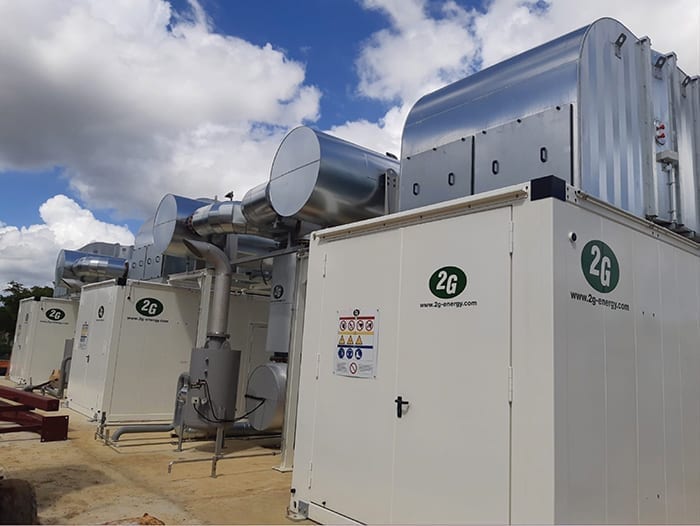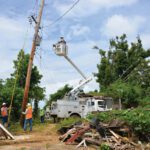Upgrades to the power grid are needed worldwide, and energy companies are working on the best solutions for providing reliable and resilient power in a cost-efficient and timely fashion. Areas hit hard by natural disasters in recent years are seeing much of the activity; lots of work is occurring in Puerto Rico, where the power grid has been devastated by hurricanes, most notably Maria in 2017. Since that storm, the island is now home to several projects designed to increase the stability of the electricity supply, and commercial and industrial (C&I) enterprises have been installing their own distributed generation systems to become more energy self-reliant and sustainable.
Viking Cold Solutions, based in Houston, Texas, recently completed work on the first phase of a cold storage facility project at a former PepsiCo bottling and distribution plant in Puerto Rico, using the company’s thermal energy storage (TES) technology. The project’s second phase will include a build-out of the facility and could eventually feature onsite solar power. The thermal storage project began when Isla Frio Refrigeration Corp., a cold storage firm, acquired the former PepsiCo facility, and decided to renovate the 147,000-square-foot building into a state-of-the-art frozen and refrigerated food warehouse. The goal of the $10 million project is to supply hurricane-resistant cold and dry storage space for the island, with the use of Viking’s TES technology to control the building’s temperature in the event of a power outage.
 |
|
1. The Enernet combined heat and power (CHP) project in Puerto Rico is being developed for a pharmaceutical company. Enernet is working with Logic Energy, AM Electric, and engine provider 2G Energy to deploy the 3.4-MW CHP system, which will provide both electricity and steam to Neolpharma. Courtesy: Enernet Global |
Enernet Global Inc., a global distributed energy service company with U.S. headquarters in New York City, provides another example. It is building a combined heat and power (CHP) project for Neolpharma Inc. PR, a pharmaceutical company, in Puerto Rico. The Enernet project (Figure 1), like many new CHP installations globally, is designed to provide affordable electricity and a robust power supply, while reducing emissions of greenhouse gases as companies move toward more sustainable business practices.
The Puerto Rico Electric Power Authority has embarked on a $20 billion plan to rebuild the island’s power grid. The initiative includes a commitment to generate 40% of the island’s power from renewable resources by 2025, and 100% by 2050. C&I enterprises using distributed power generation are a large part of the effort.
“Puerto Rico is a core market for Enernet and we are excited to be embarking on this project with Neolpharma. This CHP plant will reduce emissions by 30%, or more than 8,000 tons of CO 2 per year,” said Paul Matthews, Enernet CEO, in an interview with POWER. “Our mission is to drive the energy transition in Puerto Rico for years to come, bringing our energy-as-a-service model to industrials and communities. This delivers savings and significant carbon reductions while providing more resilient systems and energy independence—all at no capital cost.”
Enernet will build, own, and operate the plant, which is set to begin operating this month. The company is working with Logic Energy, AM Electric, and engine provider 2G Energy to deploy the 3.4-MW CHP system, which will provide both electricity and steam to Neolpharma, a subsidiary of a Mexican pharmaceutical manufacturer, under a 12-year power purchase agreement.
The Puerto Rico project is among the on- and off-grid generation projects the company has deployed in the Caribbean, Australia, the Philippines, and sub-Saharan Africa. The projects include renewable energy, battery storage, cogeneration, and upgrades to existing thermal or grid supply.
Philip Henry de Frahan, Enernet’s vice president of Business Development, added, “This system will be commissioned in March 2021. We are incredibly thankful to partners AM Electric, Logic Energy, and 2G for delivering the project in a record five-month timeframe from start to finish.”
Marco Monrouzeau, vice president of Administration and CFO for Neolpharma, said, “This plant will improve power reliability for our facility and enable us to reduce operating costs and achieve emissions reduction targets.”
Matthews said Puerto Rico, because so much of the country’s energy infrastructure has had to be rebuilt, has an opportunity to use the latest technology and achieve other goals while upgrading its power production and delivery systems. “Everyone these days, thankfully and happily, has ESG [environmental, social, and governance] goals, and targets for greenhouse gas reduction. What’s also important is that people want to pay less for their power, and that there is reliability and sustainability… to ensure that there are no frequency or voltage issues, whether it’s a hotelier in the Philippines, or a pharmaceutical company in Puerto Rico, at the end of the day, they all want to replace thermal [power] and reduce emissions, and save money.” Matthews said that also means companies are considering a range of technologies to accomplish those goals, and noted, “The focus of the [COVID-19] pandemic has brought even more focus toward reliability and cost reduction.”
The pandemic also amplified the increased need for more cold storage capacity in Puerto Rico, and the island-wide shortage of warehouse space. “Puerto Rico has always been very important to Viking Cold Solutions. Our first warehouse installation was on this beautiful island, and it’s appropriate that our first new cold storage construction project be right here in Cidra,” said Paul Robbins, the founder of Viking Cold Solutions.
Construction of the Isla Frio project began in June 2020. Robbins noted it is the company’s first system installation to be part of a facility’s original design and construction plan; previous installations have been facility retrofit projects. The TES technology means carbon emissions and energy use is minimized, power resilience and flexibility are increased, and electricity costs are lowered. The building is still connected to a large diesel generator to provide backup power, but during extended grid interruptions or power outages, the generator and its fuel can be conserved because the TES technology provides built-in temperature resilience to protect food up to several days without power.
Matthews said designing systems for C&I customers is never a “one-size-fits-all process,” but rather requires a look at several factors to determine the best solution. “We’re not a fixed solution provider,” he said. “It’s not just rooftop solar, or just CHP… it’s about tailoring the system that best meets their requirements. CHP makes sense in Puerto Rico because there is a lot of natural gas available, but not a lot of space” for large projects. “We’re looking at solar and storage solutions in Puerto Rico where there is some space” for a larger development, “in areas where customers are looking to reduce their pricing, reduce their emissions.”
Matthews noted the island nation’s long-standing problems with electricity reliability have figured into today’s planning. “The beauty of the CHP system [for a business] is, it’s baseload, it can provide 95% of load, and it’s removing the need to burn diesel. In the case of Neolpharma, we set out to design a system to best meet their load and cost requirements, where we would finance, own, and operate, using gas to provide cheaper electricity, and meet their steam and heat load requirements.” He said the company is doing similar work in the Philippines. “There are a lot of islands, and while a lot of the big ones have their own utilities, often they’re only providing eight to 12 hours of power [each day]. What we do is, we go in and build a power plant using their legacy generation, adding solar plus storage, and where there might be existing generation we give them 24/7 firm power.”
—Darrell Proctor is associate editor for POWER (@POWERmagazine).










